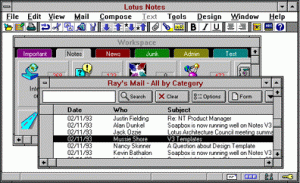
This article was started as an article about a history of Lotus Notes and then I realized that it’s better to be renamed to “Very Brief History…”.
I have been working with Notes since version 2.0 and find Notes as one of the best corroboration products ever invented.
A lack of productive marketing and advertising on a part of the current manufacturer of Notes/Domino brought Notes technology to the current state when Notes/Domino licenses are slowly but surly being replaced by MS Outlook/Exchange/Sharepoint and Google (I still can’t even remotely imagine how Notes can be replaced by Google though).
I hope that IBM will wake up and make all of us, Lotus Notes enthusiasts proud very soon.
Lotus Notes has a history spanning more than 20 years. Its chief inspiration was PLATO Notes, created by David
Woolley at the University of Illinois in 1973. In today’s terminology, PLATO Notes was a message board, and it was part of the foundation for an online community which thrived for more than 20 years on the PLATO system. Ray Ozzie worked with PLATO while attending the University of Illinois in the 1970s. When PC network technology began to emerge, Ozzie made a deal with Mitch Kapor, the founder ofLotus Development Corporation, that resulted in the formation of Iris Associates in 1984 to develop products that would combine the capabilities of PCs with the collaborative tools pioneered in PLATO. The agreement put control of product development under Ozzie and Iris, and sales and marketing under Lotus.
The first release of Lotus Notes 1.0 was shipped in 1989. According to IBM, 35,000 licenses were sold. At that time Notes ran on DOS3.1 or OS/2. the first version of Notes already had well know by now Notes features such as ACL, DocLinks, and encryption.
Fastforwarding to May 1993 when Lotus Notes R3.0 was released. By that time

according to IBM, 2,000 companies and about 5000,000 used Lotus Notes. Release 3.0 brought a few more well known Notes features such as full-text search, background and selective replication, hierarchical names, forms, views and filters (then called Macros and then Agents). Photo credit: IBM
In 1994, after the release and marketplace success of Notes R3, Lotus purchased Iris.
In June 1995 IBM purchased Lotus. “Last week’s final agreement between IBM and Lotus followed eight days of negotiations after an initial iBM offer of $3.3 billion. IBM’s sweetening of the deal was expected. Unexpected was IBM’s decision to allow Lotus CEO Jim Manzi to stay on in charge of Lotus employees.”
When Lotus Notes was initially released, the name “Notes” referred to both the client and server components. In 1996, Lotus released an HTTP server add-on for the Notes 4 server called “Domino”. This add-on allowed Notes documents to be rendered as web pages in real time. Later that year, the Domino web server was integrated into release 4.5 of the core Notes server and the entire server program was re-branded, taking on the name “Domino”. Only the client program officially retained the “Lotus Notes” name, however end users are generally unaware of this differentiation, so even though more than ten years have passed since the re-branding, references to the “Lotus Notes Server” are still fairly common.
 1999 IBM released version 5 of Lotus Notes in 1999. R5 was available on Win NT, Win 95, Win 98, OS/2, Netware and Unix.
1999 IBM released version 5 of Lotus Notes in 1999. R5 was available on Win NT, Win 95, Win 98, OS/2, Netware and Unix.
Release 6.0 was released in October 2002. This release was significantly improved Domino server scalability and UI of the Note client and iNotes. A couple of corporate client I am supporting currently is still using Notes 6.5.
Release 7 was shipped in August 2005 and the major new feature was DB2-enabled databases which for some reason I have seen being used once.
Notes and Domino Release 8 was built on the Eclipse platform and was released in August 2007. Besides the Eclipse base, new release brought amazing UI improvement in Notes Email and Calendaring, integration with Lotus Symphony, and further Domino server improvements. New design features included xPages and Webservices.
The newest released of Notes and Domino 8.5.2 was available in August 2010. This is a state of the art of Lotus Notes and Domino technology. This Notes release is available for a trial download from the IBM site. According to IBM, R8.5.3 is targeted for release earlier 2011 and will have only a few incremental improvements.
Currently the Notes client runs on Windows, Linux and Mac platforms. The Domino server runs on Windows, various Linux, AIX and I5/OS platforms.
The next major release of notes and Domino is using IBM Project Vulcan as blueprint, according to Ed Brill’s blog. I hope to descover more about future R9 release at Lotusphere 2011.
………………………………………………………………………………………………………….
Credits:
– Wikipedia,
– IBM
– Ed Brill’s blog
